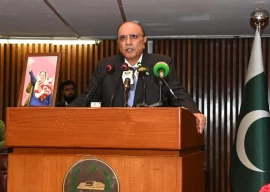
ISLAMABAD: The government has rejected the military’s proposal of using portable computers to conduct the much-delayed headcount of the country’s population and has refused to amend census forms to include transgender as a separate sex.
The decisions have come to limelight at a time when uncertainty deepens over whether the census will be held even after the Supreme Court took suo motu notice over the inordinate delay. The top court will hear the case again next week.
The General Headquarters (GHQ) had proposed using tablet computers for the census exercise to ensure fast processing and accuracy of data, finance ministry officials told The Express Tribune.
However, the Pakistan Bureau of Statistics (PBS) – the body responsible for the national headcount, termed the proposal unfeasible. The bureau said it had already printed out 42.5 million census forms and that procuring 167,000 tablets and training primary school teachers to use them would require huge resources.
However, the military’s proposal appears justified as the details of the 2011 House Listing exercise shows huge discrepancies.
Finance Minister Ishaq Dar on Saturday chaired a meeting of the PBS Governing Council to review preparedness for the next census. The meeting was informed that the military would give its own model for security arrangements in comparison to the Council of Common Interests (CCI) decision of man-to-man availability of security personnel. The Governing Council was informed that the Military Operations Directorate would reassess the availability of armed forces for census activities in November or December this year and will inform PBS.
The PBS council was also informed that the government could not recognise transgender as a separate gender in the census forum – a move that is in violation of the Supreme Court directives. The bureau said that since 42.5 million census forms had already been printed, an amendment in current forms is not possible. However, a separate code will be assigned to transgenders in the column titled sex.
Chief Statistician Asif Bajwa was not available for comments.

The Supreme Court has recently warned the government to fulfill its constitutional duty to hold census or be ready to face the music. The last population census was held 18 years ago in 1998. The national headcount becomes the base for delimitation of constituencies, determination of provincial seats in the National Assembly, distribution of national resources among the provinces and allocation of job quotas to the federating units in the civil service.
2011 House Listing Operations
The PPP government had tried in 2011 to hold the exercise but cancelled it after observing abnormal results of the House Listing Operations. On September 20, the government submitted a detailed reply in the apex court that for the first time in five years shed light on the results of the house listing.
According to the government’s response, population growth rates processed from the House Listing operations of 2011 revealed severe distortions showing over and under enumeration in some parts of the country. “The results showed that the total population of Pakistan was 192.2 million, registering annual growth rate of 2.99% during 1998-2011 period”. It was higher than 2.69% growth rate observed during 1981-1998 fifth census period, it added.
In Khyber-Pakhtunkhwa, the average annual growth rate during 1998-2011 period was 3.23% compared with 2.82% of 1981-1998 period. The 1998-2011 period showed 51.6% increase in population of K-P while there was 45.8% increase in households compared to the 1981-1998 Census data. “There was abnormal increase in population in Kohistan district (343%) and 282% increase in households. K-P’s population as per 2011 listing was 13.99% of the total population –up from 13.41%.
In Punjab, average annual growth rate for the period 1981-1998 was 2.64%, which went down to 1.67% as per 2011 listing. Punjab was the only federating unit whose population in total population of the country was shown on decline.
The census period 1998-2011 showed 24.1% increase in Punjab population and 32% increase in households. All the districts of Punjab had shown decline in average annual growth rate, Lahore district being lowest at 0.94%. Punjab’s population was observed at 47.52% of the total population during the 2011 listing, which was 55.60% as per 1998 Census, according to the PBS.
In Sindh, annual average growth rate for the period 1981-1998 was 2.8% whereas it was recorded at 4.66% for 1998-2011 period, stated the PBS. The census period 1998-2011 showed 81.5% increase in population and 83.9% increase in households. All the districts of Sindh have shown increase in average annual growth rate. Hyderabad showed 129.4% increase, Karachi 114.5% increase, Jacobabad 111.4% increase and Jamshoro 102.2% increase. The Sindh population as per 2011 house listing was 28.73% of the total population, which was just 22.9% as per the 1998 Census.
In Balochistan, average annual growth rate for the 1998-2011period was 6.9% while it was only 2.47% as per 1998 Census. The 2011 listing showed 139.3% increase in population and 109.2% increase in households in Balochistan. The proportion of the population in total population was just 4.96% in 1998 that went up to 6.85% as per 2011 listing.
Published in The Express Tribune, October 2nd, 2016.
























































COMMENTS
Comments are moderated and generally will be posted if they are on-topic and not abusive.
For more information, please see our Comments FAQ